| Art Q&A > Architecture |
|
|
Forbidden City Lying at the center of Beijing, the Forbidden City, called Gu Gong in Chinese, used to be the imperial palace of the Ming and Qing dynasties (1368-1911). It is called the Palace Museum now. It lies 1 kilometer north of the Tian'anmen Square, with its south gate, the Gate of Devine Might (Shenwumen), facing the Jingshan Park.
Generally, it was divided into two parts, the northern half, or the Outer Court where emperors executed their supreme power over the nation and the southern half, or the Inner Court where they lived with their royal family. Until 1924 when the last emperor Puyi was driven out of the Inner Court, 14 emperors of the Ming Dynasty (1368-1644) and 10 emperors of the Qing Dynasty (1644-1911) had reigned here. Being the imperial palace for about 500 years, it houses numerous rare treasures and curiosities. It was listed by the UN as World Cultural Heritage in 1987 and is the hottest tourist magnets in China.
Since yellow is the symbol of the royal family, it is the dominant color in the Forbidden City. Roofs are built with yellow glazed tiles; decorations in the palace are painted yellow; even the bricks on the ground are made yellow in special process. However, there is one exception. Wenyuange, the royal library, has a black roof. The reason is that it was believed black represented water then and could extinguish fire.
There were strict rules to follow when people enter the Forbidden City. Entering through the central opening was the emperors' exclusive privilege, while their empresses were allowed to go through the opening once on their wedding day. The top three in the national examinations, presided by emperors on the final stage, would be honored to strut through the arched hole after receiving emperors' interview. The east opening was for the ministers while the west opening was for the royal family. The other openings were for petty officials.Ordinary people were forbidden to enter the city.
In the ancient time, emperors would bestow foods to ministers on days of important Chinese solar terms. On the first day of October on solar calendar every year, emperors would issue next year' calendar. After wars, Emperors would receive captives themselves here. Also on the left side of the Imperial Way, which goes through the central opening, baculine penalty would be executed on those who offended emperors.
The river is called the Inner Golden River and the bridges called the Inner Golden River Bridges. The central bridge is reserved for emperors exclusively. The two flanking it are reserved for royal family members while the two outside are for ordinary officials. The bridges are well decorated with marble balustrades carved with motifs of dragon and phoenix. The river serves as fire hydrant as well as decorations.
The courtyard beyond covers a space of 10,000 square meters. There are no trees on the square since in ancient China emperors considered themselves Son of Heaven, born to reign over the country, so they should occupy the highest position. Nothing was allowed to overwhelm the Hall of Supreme Harmony, the highest building in the Forbidden City and trees were no exception.
The ground in the palace was laid in a very special way -- seven layers lengthwise and eight layers crosswise, totaling fifteen layers to protect assassins from digging tunnels into the palace. And the bricks were specially made to sound nice when walking on. The rooms on each side were said to serve as warehouses for storing such items as fur, porcelain, silver, tea, silk, satin and clothes.
Taihemen, north of the square, is the main gate of the Outer Court and fairly grand. The gate is guarded by a couple of gilded bronze lions which were aimed to show imperial dignity. The east one is male, with its front right paw put on a ball, meaning imperial power extended worldwide. The lioness on the west puts its front left paw on a lion cub, indicating prosperously growing family.
The gate is an important place where emperors' wedding ceremonies were usually held.
The hall was first built in 1406 and later repaired many times. As the heart of the Forbidden City, the so-called Golden Carriage Palace, used to be the place where emperors received high officials and practiced their rule over the nation. Also grand ceremonies would be held to celebrate new emperor's ascending to the throne, emperors' birthdays and wedding ceremonies and other important occasions such as Winter Solstice, the Chinese New Year and dispatching generals into war fields.
Along the three-tier terrace stairs, there are 18 bronze Dings, a kind of ancient Chinese vessel, to represent 18 provinces of the nation then. On the terrace, which was luxuriously balustraded, a bronze crane and a bronze tortoise can be seen. They were put there to expect everlasting rule and longevity. The marble Rigui, an ancient timer in the east and the Jialiang, an ancient measuring vessel in the west were put there to show that emperors were just and fair. In front of the hall, there are a couple of gilded bronze vats, which were used to hold water in case of fire.
Since the Hall of Supreme Harmony was the symbol of imperial power, it was the highest structure in the Ming and Qing dynasties in the nation, no other buildings allowed higher than it. The heavily glazed hall is 35.02 meters high and 37.44 if rooftop decoration counted, and 63.96 meters in width and 37.2 meters in length respectively. There are totally 72 pillars standing in six rows to support the roof. Gates and windows were embossed with clouds and dragons.
Inside of the hall, the floor was paved with special bricks which were fired long and then soaked in tung oil to be polished. As a symbol of imperial power, the sandalwood throne, standing on a two-meter high platform, is located in the center of the hall and enclosed within six thick gold-lacquered pillars painted with dragons. The golden throne is carved with dragons all over. Around the throne stand two bronze cranes, an elephant-shaped incense burner and tripods in the shape of mythical beasts. The hall is heavily painted with dragons, having an aura of solemnity and mystery. In the middle of the ceiling is the design of two dragons playing with pearls. They were made of glass and painted with mercury. The pearl was said to be able to detect any usurper of the imperial power. If anyone who was not the descendant of the Emperor Huang Di usurped the throne, it would drop down and strike him to death.
Inside of the hall, visitors can see there is one golden unicorn on each side of the throne in the center of the hall. The couple of golden unicorns, called luduan in Chinese, were believed capable of traveling 9,000 kilometers a day and speaking many languages. Since the divine beast foresees faraway, it was put beside the throne to indicate emperors' wisdom and brilliantness. They used to be sandalwood burners. Beside the throne, there are also two sedan chairs, which were used as emperors' vehicles to shuttle around in the Forbidden City.
In 1789, middle of the Qing Dynasty, Emperor Qianlong removed Palace Examination, the highest level and final stage of the nationwide imperial examination system, from the Hall of Supreme Harmony to this hall. Emperors would read papers of the top ten candidates to honor them.
In rainy days, visitors will have chance to see the spectacular scene of a thousand dragons draining water. There are 1,412 marble stone dragon heads under the columns of the three-tiered terrace on which the three main halls are seated. Chinese artisans smartly combined drainage system with architectural art. Once you get a chance to the Forbidden City, please notice the holes in dragons' mouths. However, the ones in the corners have no holes.
Behind the Hall of Preserving Harmony, in the middle of the stairway, is a huge piece of marble carving of nine dragons playing with pearls. It is the biggest stone sculpture in the Forbidden City. It was originally sculpted in the Ming Dynasty and re-sculpted in the Qing Dynasty. In the Ming and Qing dynasties, anyone who was caught touching this holy stone would be punished by death penalty! The huge stone was hauled into the palace all the way from Fangshan, about 70 kilometers away from Beijing city proper. The hard transportation took about a month and 20,000 men and thousands mules and horses. The 16.57 meters long, 3.07 meters wide and 1.7 meters thick stone weighs about 250 tons.
In the Qing Dynasty, it was the place where emperors, sitting on the throne set in the middle of the gate, heard reports and made decisions. The huts standing left and right are duty rooms and waiting rooms for ministers waiting for interviews, etc.
Outside of the gate, against the red wall are ten gilded bronze vats, shining. The huge vats are decorations and reservoirs in case of fire. Every one of these vats weighs 4 tons itself and can hold 4 tons water. There are totally 308 vats in the whole palace, including 22 of this kind.
The Palace of Celestial Purity is the smaller twin of the Hall of Supreme Harmony. Every item similar with that of the Hall of Supreme Harmony is smaller than the latter. However, it is the largest structure in the Inner Court since it is superior to any other structures in the Inner Court. It was built in 1420 and rebuilt in 1798. Ming emperors and the first two Qing emperors live inside the palace and attended to daily state affairs. They also read, signed documents, interviewed ministers and envoys. Banquets and rites occasionally would be held here too. In 1722 and 1785, Banquet for A Thousand Seniors was held here twice. Old men over 60 from the nation presented the events.
Moreover, in the Qing Dynasty, no matter where the emperor died, his coffin should be set in the palace for a few days to hold memorial ceremonies. Later the coffin would be moved to Jingshan, and then buried in the mausoleum on a selected day.
In the middle of the palace, the throne is seated on stairs, surrounded by decorations like cloisonne incense burners, long red candles, and big mirrors, which were placed beside the throne to ward off evil spirits. On the columns surrounding, there are two pairs of couplets written by Qing emperors. Over the throne hangs a plaque engraved with four Chinese characters, which were written by Emperor Yongzheng and means Justice and Brightness. From Emperor Yongzheng, crown princes' name would be written on duplicate documents and a copy would be hidden in a box behind the plaque. The other copy would be carried by the emperor. If the designated names on the two copies were the same, the designated prince would take the crown.
To the right of the throne, visitors will see ancient Chinese water pot-equivalent of sandglass and to the left there is a chime clock. The two timers used to be the reference of the Drum Tower and the Bell Tower. In addition, the palace also holds 25 imperial seals. Since Emperor Qianlong hoped that the Qing Dynasty could last 25 reigns to exceed the Eastern Zhou Dynasty (770-256BC), the longest dynasty in China. However history disappointed him, the Qing Dynasty only lasted ten reigns.
In the West Warmth Chamber, sacrifice would be held every day. On important occasions, emperors and empresses would preside over the ceremonies themselves.
Behind the palace, it is the Kunningmen, the Gate of Terrestrial Tranquility, with imperial doctors' duty room, dispensary and eunuchs duty room flanking it.
The hall has a front hall and a rear hall which was the emperor's bedroom. In the center of the front hall, emperors summoned their ministers to consult state affairs. On the bookshelf behind the throne, there used to be books prepared for a new emperor to show him how to reign. In the East Warmth Chamber, the notorious Empress Dowager Cixi attended to state affairs behind curtain here. The chamber is now displayed same as her time. She ruled China behind a yellow curtain for 48 years here under her policy of quislism. In the West Warmth Chamber, emperors from Yongzheng to Xianfeng interviewed their ministers to consult or give secret orders. The small house in the west end is named Sanxitang (Hall of Three Rare Treasures), since Emperor Qianlong collected and held three outstanding calligraphy masterpieces by Wang Xizhi, Wang Xianzhi, and Wang Xun, three masters in Chinese calligraphy. There still hang plaques written by Emperor Qianlong.
The lobby extending between the center of the front hall and the rear hall connects them. There are five imperial bedrooms, one in the center and the other four flanking it. The courtyards east and west of the rear hall, are temporary lodgings of empresses and concubines respectively when they were granted interview and bed time with Emperors. They were forbidden to come here without the emperors' permission.
On February12th, 1912, under the heavy blow of the Revolution of 1911 led by Dr. Sun Yat-Sen, Emperor Dowager Longyu presided over the final cabinet meeting of the Qing Dynasty, and was forced to decide abdication and sign the imperial abdication declaration here. However, the imperial family was privileged to stay in the Inner Court until 1924 when they were driven out by General Feng Yuxiang.
Chuxiugong (Palace of Gathering Elegance) is the most famous one among the six since the notorious Empress Dowager Cixi lived here for a long period. When hierarch Cixi was in power, although she was behind the throne, she spent huge amount of money to decorate the palace, making it the most luxurious one to celebrate her 50th birthday in 1884. Now it is exhibited to visitors same as that time.
Outside on the stone stands, there are a couple of bronze dragons and a couple of bronze deer. Inside, original delicate pieces of furniture and decorations now on display are all original pieces when Cixi used.
Fengxiandian (Hall for Ancestral Worship) was built in 1656 during the Qing Dynasty. It has a front hall and a rear hall, which are connected, by a lobby. Its main function was to offer sacrifices to imperial ancestors. Grand sacrifices ceremonies would be held in its front hall on important occasions. On the days of their ancestors' birth, death and traditional festivals, ceremonies would be held in the rear hall.
Now the hall is open to the public as Clock and Watch Exhibition Hall. Different kinds of clocks and watches were given as gifts to the imperial family by foreign envoys in the Qing Dynasty, worth seeing.
Dongliugong (Six Eastern Palaces) consists of Jingrengong (Palace of Great Benevolence), Chengqiangong (Palace of Celestial Favour), Yonghegong (Palace of Eternal Harmony), Jingyanggong (Palace of Great Brilliance), Zhongcuigong (Palace of Purity) and Yanxigong (Palace of Lasting Happiness).
The palace complex stands on the east side of the Inner Court. Most of the palaces were restored in the 17th century. These palaces were also the living quarters of the imperial concubines. Now mostly of them have been turned into exhibition halls where Chinese treasures used to be collected by the imperial family are displayed to the public.
Jingrengong (Palace of Great Benevolence) now holds exhibition of more than 500 pieces Bronze wares of ancient China with other two halls, Zhaigong and Chengsudian. Visitors will see magnificent bronze wares displayed there.
In Chengqiangong (Palace of Celestial Favour) and Yonghegong (Palace of Eternal Harmony), now the Pottery and Porcelain Exhibition Hall, visitors will be privileged to appreciate pottery and porcelain wares dated from the Neolithic Age to the Qing Dynasty.
Jingyanggong (Palace of Great Brilliance) has turned into an exhibition hall displaying lacquer wares, jade wares, stonewares, glasswares and metal wares etc., from the Ming and Qing dynasties. It is now Ming and Qing Crafts Exhibition Hall.
The screen indicates emperors' supremacy by arranging nine dragons in the front and 5 on the edge, since they did believe nine is the largest single number and 5 the middle, representing Heavenly Son in combination.
The belly of the third white dragon was inserted with a piece of wood. A Story tells that it was fired broken in the kiln, which meant nobody would be alive. A carpenter repaired it with a piece of wood.
Ningshougong (Palace of Peaceful Longevity), a group of structures, were first built in 1689, and named. When rebuilt in 1772, the name was replaced with Huangjidian (Hall of Imperial Supremacy). However, the rear hall was still named Ningshougong (Palace of Peaceful Longevity). The structures here were shrunken Forbidden City since it was rebuilt for Emperor's abdication. Now painting exhibition is held here to show famous paintings dated from the Jin Dynasty (265-420) to the Qing Dynasty. The halls and adjacent houses have a collection of more than 100,000 pieces.
The hall was Emperor Qianlong's study after his abdication. It is spacious and has lobbies around. In 1894, Emperor Dowager Cixi, pretending to return power to Emperor Guangxu, lived here also and slept in the west warmth chamber. Her 60th birthday celebration was also held here.
Outside of the northern gate of the hall, the largest jade sculpture in the Forbidden City is placed. The sculpture is named Duyu Trying to Control Water and weighs 1.07 tons. The jade was dug from in Xinjiang, and freighted to Beijing then Yangzhou to be carved. After it was finished and shipped back to Beijing, ten years pasted. The delicately designed and superbly sculpted jade is very eye-catching.
Now the hall and adjacent Yangxingdian (Hall of Mental Cultivation) hold exhibition of ancient gold wares, silver wares, jade wares and imperial costumes etc. The treasured ivory mat deserves special attention. It is 216 cm long and 139 cm wide, made of delicate ivory strips. It is said that the mat was woven about 250 years ago.
Qin'andian (the Hall of Imperial Peace) is the main structure in the garden and the only one on the central axis and stands in the center of the garden, encircled in a rectangular wall. It was first built in the 15th century. In front of the hall, there is a 400-year-old consort pine, symbolizing harmony of the emperor and the empress. Two gilded unicorns, supposed to protect the hall from evil spirits, guard the door. Inside the hall, Zhenwudadi (God of Water in the Taoism) was worshiped, since he was supposed to protect the Forbidden City from fire.
On the four corners of the garden, there is one pavilion at each, symbolizing the four seasons respectively. The Pavilion of Myriad Springs is the most famous one and lies in the east corner of the garden. It was built in 1535 and restored during the Qing Dynasty. This pavilion symbolizes the spring, and undoubtedly, there are also three other pavilions which represent summer, autumn and winter respectively.
Duixiushan (Gathering Beauty Hill) is a little artificial mountain with a cave. It is located in the northeast. Yujingyuan (Pavilion of Imperial View) sits on top of the mountain. Emperors would climb up to the pavilion on the Double Ninth Festival to enjoy the scenery with the royal family.
In the garden, visitors will find some footpaths paved with colorful pebbles, which form different patterns, usually symbolizing luck and fortune. The north end of the garden is Shenwumen (the Gate of Devine Might) and the rear gate of the Forbidden City. |
||
All rights reserved. Reproduction of text for non-commercial purposes is permitted provided that both the source and author are acknowledged and a notifying email is sent to us. |
||
 |
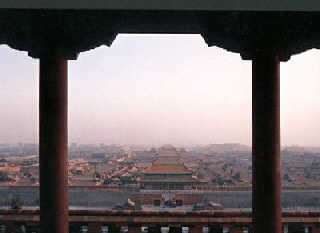
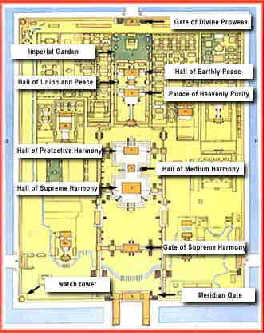
 Wumen (The Meridian Gate)
Wumen (The Meridian Gate)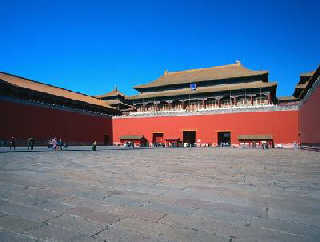
 Taihemen (Gate of Supreme Harmony)
Taihemen (Gate of Supreme Harmony)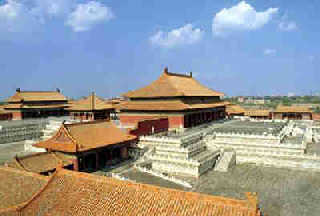
 Taihedian (Hall of Supreme Harmony)
Taihedian (Hall of Supreme Harmony)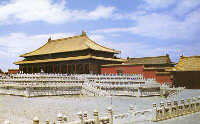
 Zhonghedian (Hall of Central Harmony)
Zhonghedian (Hall of Central Harmony)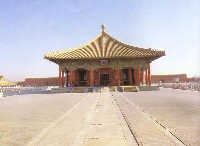
 Baohedian (Hall of Preserving Harmony)
Baohedian (Hall of Preserving Harmony)
 Huge
Stone Carving
Huge
Stone Carving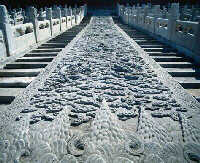
 Qianqingmen (Gate of Celestial Purity)
Qianqingmen (Gate of Celestial Purity) 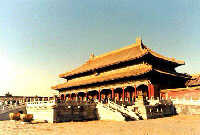

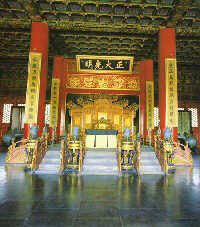

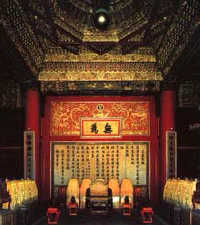
 Kunninggong (Palace of Earthly Tranquility)
Kunninggong (Palace of Earthly Tranquility)
 Yangxindian (Hall of Mental Cultivation)
Yangxindian (Hall of Mental Cultivation)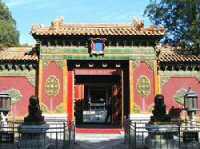
 Xiliugong (Six Western Palaces)
Xiliugong (Six Western Palaces)
 Fengxiandian (Hall for Ancestral Worship)
Fengxiandian (Hall for Ancestral Worship) Dongliugong (Six Eastern Palaces)
Dongliugong (Six Eastern Palaces) Nine Dragon Screen
Nine Dragon Screen

 Leshoutang (Hall of Happiness and Longevity)
Leshoutang (Hall of Happiness and Longevity) 
